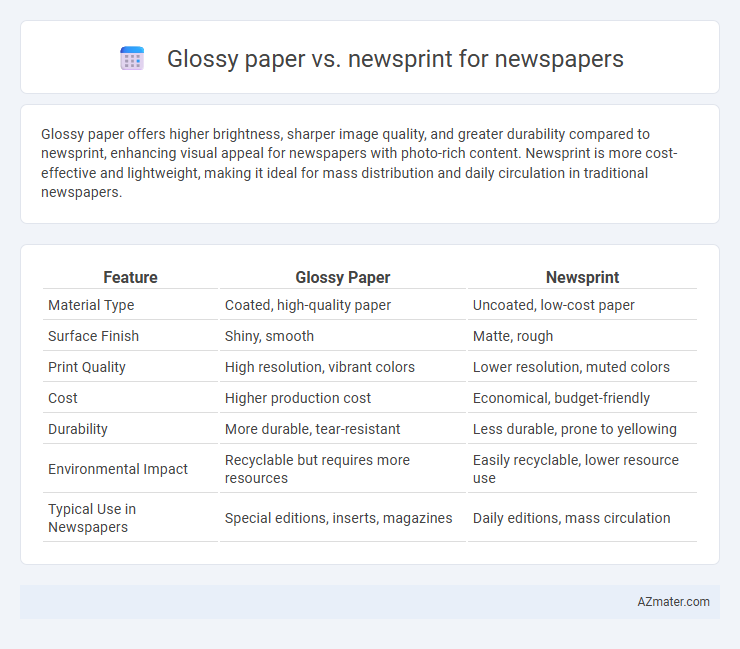Glossy paper offers higher brightness, sharper image quality, and greater durability compared to newsprint, enhancing visual appeal for newspapers with photo-rich content. Newsprint is more cost-effective and lightweight, making it ideal for mass distribution and daily circulation in traditional newspapers.
Table of Comparison
| Feature | Glossy Paper | Newsprint |
|---|---|---|
| Material Type | Coated, high-quality paper | Uncoated, low-cost paper |
| Surface Finish | Shiny, smooth | Matte, rough |
| Print Quality | High resolution, vibrant colors | Lower resolution, muted colors |
| Cost | Higher production cost | Economical, budget-friendly |
| Durability | More durable, tear-resistant | Less durable, prone to yellowing |
| Environmental Impact | Recyclable but requires more resources | Easily recyclable, lower resource use |
| Typical Use in Newspapers | Special editions, inserts, magazines | Daily editions, mass circulation |
Introduction to Newspaper Paper Types
Newspaper paper types primarily include glossy paper and newsprint, each serving distinct purposes for print quality and durability. Glossy paper offers a smooth, shiny finish that enhances image vibrancy and sharpness, ideal for high-quality photo spreads and advertisements. Newsprint, a lightweight, uncoated paper made from recycled fibers, provides cost-effective mass production with sufficient readability, widely used for standard daily newspapers.
What is Glossy Paper?
Glossy paper is a high-quality, coated paper featuring a shiny finish that enhances color vibrancy and sharpness in newspaper printing. It provides a smooth surface that improves image clarity and visual appeal, making it ideal for magazines or special supplement sections. Compared to newsprint, glossy paper offers better durability and a more premium look but comes at a higher production cost.
Understanding Newsprint Paper
Newsprint paper is a lightweight, inexpensive, and uncoated paper commonly used in newspapers due to its high absorbency and quick drying properties. It offers good print contrast and readability but lacks the shine and durability of glossy paper, which is coated and designed for vibrant images. Understanding newsprint paper helps publishers balance cost-efficiency with the need for clear text, making it ideal for large-volume newspaper printing.
Printing Quality: Glossy vs Newsprint
Glossy paper offers superior printing quality compared to newsprint, providing sharper images and more vibrant colors due to its smooth, coated surface that enhances ink absorption and reflectivity. Newsprint, being uncoated and made from cheaper, lower-quality fibers, results in duller colors and less precise image reproduction, often exhibiting ink bleed and reduced detail clarity. The choice between glossy and newsprint significantly impacts visual appeal, with glossy paper preferred for high-quality photo-centric content and newsprint commonly used for cost-efficient mass circulation.
Color Reproduction and Visual Appeal
Glossy paper enhances color reproduction with its smooth, coated surface, resulting in vibrant, sharp images that significantly improve the visual appeal of newspapers. Newsprint, being uncoated and more porous, absorbs ink unevenly, producing duller colors and less crisp visuals. For newspapers aiming to showcase high-quality photographs and bold graphics, glossy paper offers a superior aesthetic impact compared to traditional newsprint.
Cost Comparison: Glossy Paper vs Newsprint
Glossy paper is significantly more expensive than newsprint, with prices often ranging from 20% to 50% higher due to its coating and higher quality finish. Newsprint remains the most cost-effective option for newspapers, priced around $0.20 to $0.40 per pound compared to glossy paper's $0.50 to $1.00 per pound. Publishers favor newsprint for bulk printing to minimize production costs without compromising the distribution scale.
Environmental Impact and Sustainability
Glossy paper, often coated with clay and polymers, is less environmentally sustainable due to higher energy consumption in production and challenges in recycling compared to newsprint, which is typically uncoated and made from recycled fibers. Newsprint's lower carbon footprint and better biodegradability make it a more eco-friendly choice for newspapers, supporting circular economy principles. The use of newsprint reduces landfill waste and conserves resources, aligning with sustainable publishing practices.
Durability and Handling
Glossy paper offers higher durability compared to newsprint, resisting tears and moisture better while maintaining crisp print quality. Newsprint, being thinner and more porous, is prone to yellowing and deterioration over time, making it less suitable for long-term handling. For newspapers requiring prolonged use or archival purposes, glossy paper provides a stronger, more resilient option.
Reader Experience and Perception
Glossy paper enhances reader experience by delivering sharper images and vibrant colors, creating a premium perception for newspapers that focus on high-quality visuals. Newsprint offers a more traditional, textured feel that readers associate with authenticity and faster absorption of text-heavy content. Readers often perceive glossy paper as modern and upscale, while newsprint conveys reliability and classic journalism values.
Choosing the Right Paper for Your Newspaper
Glossy paper enhances newspaper visuals with sharper images and vibrant colors, ideal for magazines or special editions that emphasize photo quality and advertising impact. Newsprint remains the economical and widely used choice for daily newspapers due to its affordability, lightweight nature, and quick drying time. Selecting the right paper depends on budget constraints, target audience preferences, and the newspaper's intended purpose, balancing print quality with cost efficiency.

Infographic: Glossy paper vs Newsprint for Newspaper
 azmater.com
azmater.com